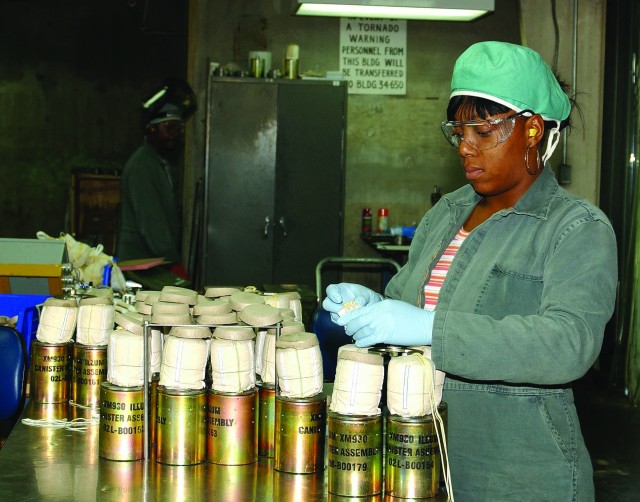Pine Bluff Arsenal's Directorate of Ammunition Operations answered the call recently when they were tasked to produce a lot of M930 120MM illumination mortars six months ahead of schedule.
"The nice part about working with Pine Bluff and Crane Army Ammunition Activity is the fact that I don't have to do a contractual action every time I want something," said Sal Ghazi, project officer with Project Manager Combat Ammunition Systems at Picatinny Arsenal, N.J. "We can move stuff around freely as parts become available. We can respond quickly to the warfighter."
CAAA, located in Indiana, produces illumination and infrared candles that are used in the body loads of the M930 and M983. "The folks at Crane went to two shifts to get them done early for this particular allotment," said Ghazi.
Ghazi said in the case of the M930s, there was a request to pull them up six months early from Brig. Gen. Larry Wyche, commander of U.S. Army Joint Munitions Command.
"Within days, we knew exactly what we needed to do," he said. "These were scheduled to be completed by Dec. 2009 and have been completed by July 2009. The fact that we can rearrange work load based on theater need is the good part about working with Pine Bluff."
Over 70,000 M930 have been assembled at PBA in the past four years, according to Ghazi. "These mortars are being shot at over a 1,000 a month in theater," he said. "There is a high demand for them."
The Arsenal hasn't failed a lot acceptance test on their mortars since 2005, said Roch Byrne, AO director. "This has been outstanding," said Byrne. "For a big part of the year, our folks are working for CAS making mortars. We all work very well together - my folks and Sal's folks. AO has a great team."
"Pine Bluff has built over 800,000 mortars in the past four years," said Ghazi. "This is definitely a good news story."
Production has also kicked off the M819 81MM red phosphorus line. "We make the RP, blend it and press it into wedges. It is then loaded and packed out. The only big difference on this line is we actually produce the mix," said Byrne. "This is a mortar that produces a white smoke for screening purposes."
Byrne said that this particular lot of M819s is a significant order. "We are producing approximately 70,000 for the U.S. Marine Corps," he said. "It takes quite a bit of time to do this."
The new equipment on the M485 line is also doing very well, he said. "We had some bugs to work through but that is about typical. We have to work through them to get where we are," said Byrne. "We have reduced the number of folks that work on that line by 10 percent and are able to use them in other places."
Production is also zeroing in on the two million mark with the M18 colored smoke grenade program. "We have completed 189 successful lot acceptance tests," said Byrne. "We are currently at 1,828,092 grenades."


Social Sharing